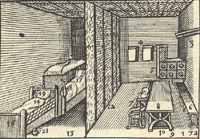 |
||
| The Use of Places | ||
| HOME The Art of Memory Origin Myth Vivid Imagery Memory Is Personal Your Inner Monty Python The Use of Places Poetry and Song The Grid System Why It Works The Number Mnemonic Free Ass-sociate Conclusion |
In ancient Greece and Rome, practitioners of the art of memory made a habit of “collecting” places for use in their art. Every new town they visited, they would find suitable buildings (they were best if they were brightly lit, not too cluttered or noisy or crowded) and they would walk through them, taking them in and memorizing them, and marking off places at regular intervals (usually in groups of five or ten) that would serve later as memory loci. Then, when memorizing something like a speech or a legal discourse, they would mentally walk through that space and plant their vivid imagery at each locus. Recalling the material when needed was simply a matter of taking a mental stroll through this remembered space, collecting the vivid tableaux deposited at each mental locus. If you use your place of employment, say, as a memory space, then decide on a typical path through the establishment, beginning at the front door of your building, say, and moving through the lobby, the elevator, the front door of your office, the receptionist’s desk, then each individual office as you go down the corridor; if they are sizable offices and not cubicles, you can usually fit five places in each one – it’s best for organizational structure if they conveniently break down into groups of five (e.g., building entrance to receptionist – five stations; then five stations or places in each office you visit in sequence; don’t forget the bathroom, the conference room, the lunchroom, the supply closet…). The use of the place mnemonic is a natural outgrowth of the way memory for facts is keyed to our physical surroundings. For nonliterate societies, the places of the physical world become a sort of lived-in memory space. I stayed for a while in a remote village in Papua New Guinea, surrounded by rainforest. To my eyes, the forest was dense and beautiful, but without variety. Space had no meaning there. But my local companions and guides would often stop and point at some bent root, some certain small rise or gulley, and laugh, remembering something funny so-and-so had said in that spot, or remembering a particular pig they had killed there. The jungle was, for them, a familiar landscape of memory. Our urban and suburban environments work the same way, even if we're not conscious of it. When trying to remember material you read or hear, it is very helpful to notice your surroundings, the weather, the sensory details like smells, noises (children playing, a work crew outside), what the lecturer is wearing (if it is a class), and the physical location you are sitting in. By extension, the “place” on the page, if you are learning the material from a book, is also an important part of helping you remember. We’ve all had the experience of trying to hunt down some fact in a book, remembering that it was in the lower left corner of some page. The art of memory simply utilizes and amplifies the way the mind naturally keys memories to the details of setting and circumstance. Medieval illuminated manusripts were designed to utilize this principle. The unique decorations, bizarre marginalia, colorful capitals, etc., created by Medieval scribes were all meant to give each page a vivid, unique visual structure to assist readers in the act of recalling the material later. Seem strange? Look at a modern, well-designed Web page. Same thing. |
|
All material copyright 2006
Eric Wargo
